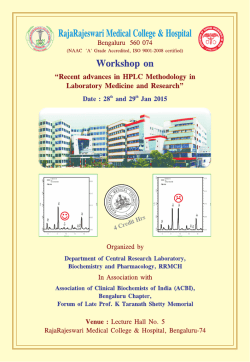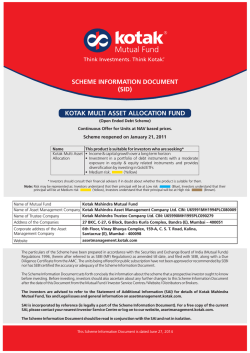
Application of Human Error Prevention Principles
Application of Human Error Prevention Principles Rajinder Singh Mahindra Institute of Quality Mahindra and Mahindra Ltd Mumbai 1 INTRODUCTION : Mahindra and Mahindra Ltd AUTOMOTIVE & FARM SECTORS FINANCIAL SERVICES SECTOR INFORMATION TECHNOLOGY SECTOR SYSTEM SECTOR MAHINDRA PARTNERS TWO WHEELER SECTOR INFRASTRUCTURE & REALITY SECTOR AFTERMARKET SECTOR HOSPITALITY SECTOR DEFENCE SYSTEM 10 BUSINESS SECTORS : USD 16 BILLION 2 Mission MIQ aims at making “Quality” a way of life & imparting TQM competence to organizations 3 Why Human Error Prevention at Mahindra? Many Manual assembly operations Increasing use of temporary workmen Complexity of operations Conventional means like education and training have not yielded zero defects Areas selected for application: 1. Press Shop 2. Body Shop 3. Assembly Line 4 Human Error Proofing Improvement of work operations, including materials, machines and methods, with the aim of preventing problems due to human error. Improve Human Beings to Fit Operations Improve Operations to Fit Human Beings 5 Mahindra’s Human Error Prevention Application Approach 1.Find out opportunities for improvements 2.Horizontal deployment 1.Monitor Quality Indicators 2.Monitor Number of Improvements 1.Design check list 2.Plan Implementation Strategy 3.Plan training methodology PLAN ACT 6 DO CHECK 1.Training and involve all officers and operators 2.Find out improvements 3.Implement solutions 6 11 DEFECT Flow Chart PROCESS CONFIRMITY ANALYSIS (LO) IS THE DEFECET BECAUSE OF HUMAN ERROR N FOLLOW QC STORY Y HUMAN ERROR CHECK LIST DIFFERENT POSSIBLE SOLUTIONS ANALYSE THE SOLUTIONS ACTION PLAN IMPLIMENT SOLUTION/S CHECK Y EFFECTIVENESS N PROBLEM CLOSURE 7 1) Training to operators for Understanding of theory 2) Take 1 problem from daily work 3) Put the problem in Human Error Prevention Checklist 4) Generate different solutions 5) Evaluate the solutions on SPN 6) Select the solution for Implementation 7) Implement the solution 8) Monitor the effectiveness of implemented solution TRIAN AND APPLY in QC CIRLCE 8 9 HEP Case Studies 10 Case Study 1 – Missing or Wrong Spare fuse assembly 11 Concern – Missing Fuse or Wrong fuse getting assembled in the fuse flap 12 Before Process 13 Improved Process 14 Case study 2 – Wrong badges fitment 15 Concern – Wrong badges fitment 16 After Process 17 Case study 3 – Unsafe Condition at Engine compartment sub-assembly station 18 Concern – Possibility of an unsafe condition at Engine compartment station if Operator forgets to clamp the fixture Effect on Customer – Engine Compartment falling down which may result in Accident ! 19 Before Process Video - 20 Improved Process - 21 Principle W ise Application Principle % Improvements Elimination 13 Replacement 18 Facilitation 33 Detection 21 Mitigation 15 22 Results and conclusions 62% reduction in Quality concerns due to Human errors 52% reduction in incidents due to unsafe acts Due to TEI in HEP, it was possible to achieve good results Improve operations to fit human beings rather than only improving human beings to fit the operations Acknowledgements: 1. Dr. Takeshi Nakajo from Chuo University Japan 23 THANK YOU 24
© Copyright 2025





